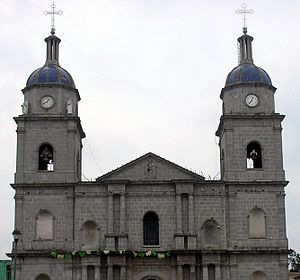Tuxpan, Jalisco
| Tuxpan de la Sal | ||
|---|---|---|
| Municipality and city | ||

Tuxpan's main Catholic Church
|
||
|
||
 Location of the municipality in Jalisco |
||
| Location in Mexico | ||
| Coordinates: 19°33′14″N 103°22′32″W / 19.55389°N 103.37556°W | ||
| Country |
|
|
| State | Jalisco | |
| Area | ||
| • Total | 550.23 km2 (212.44 sq mi) | |
| Population (2005) | ||
| • Total | 33,652 | |
| Time zone | Central Standard Time (UTC-6) | |
| • Summer (DST) | Central Daylight Time (UTC-5) | |
Tuxpan is a town and municipality in the Mexican state of Jalisco . The name "Tuxpan" comes from the Nahuatl word tochpan, a word used to describe where rabbits live or possibly place of abundant rabbits. Some others translate it as a location above the river.
Tuxpan is located in the southern part of the state of Jalisco, between coordinates 19 13 "11 'north latitude between 103 18" 17' with average height of 1,900 m above sea level. The average annual temperature is 21 C, the maximum average of 30 C and the minimum of 13 C. Within the terrain of the hill town highlights of Cihuapilli with 1724 masl. The Tuxpan River (known locally as Tizatirla) crosses the town.
According to historical records of local monographs, Tuxpan was founded by the Toltec pilgrimage in the year 642 of our era. Later in the year 1529, the Spanish came to the population under the commands of Francisco Cortés de San Buenaventura, nephew of Hernán Cortés. However, the Franciscan friars founded the village in 1536, noting the trace and built a convent in that year dedicated to San Juan Bautista. Later, an eight-sided cross was built with a based quadrangular. It is currently the oldest colonial monument of Jalisco.
The municipality of Tuxpan has 92 locations. Being the most populous delegations:
This dish is a kind of salty atole, a thick soup with a doughy consistency that is cooked in chicken soup, guajillo chilies, tomatoes, lard or oil, and fresh oregano. Added on top is shredded chicken meat, it is served in a mud bowl (similar to clay). It is an exquisite meal that is served especially for lunch.
Commonly made during Mexico's Easter week (during Lent), the dish is prepared with the following ingredients: white beans, cilantro, Guajillo chiles, onions, garlic, and cloves. Once cooked, it is served with a tortila, folded into four parts.
...
Wikipedia


